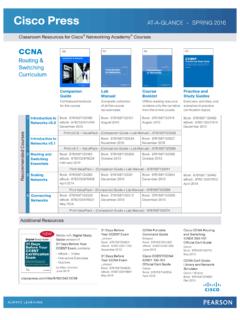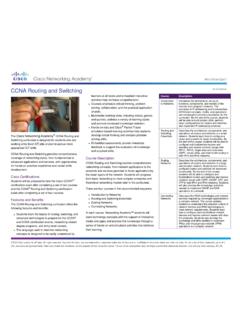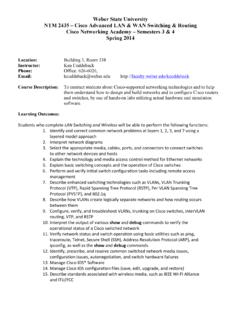Transcription of Introduction to Scaling Networks - Managementboek.nl
1 CHAPTER 1. Introduction to Scaling Networks Objectives Upon completion of this chapter, you will be able to answer the following questions: Q How is the hierarchical network used in Q What types of routers are available for small- small business? to medium-sized business Networks ? Q What are the recommendations for design- Q What are the basic configuration settings for ing a network that is scalable? a Cisco IOS device? Q What features in switch hardware are neces- sary to support small- to medium-sized busi- ness network requirements? Key Terms This chapter uses the following key terms. You can find the definitions in the Glossary. hierarchical network page 3 failure domain page 9. Cisco Enterprise Architecture page 3 multilayer switch page 10. enterprise network page 4 cluster page 11. reliability page 5 EtherChannel page 11.
2 Access layer page 6 Spanning Tree Protocol (STP) page 12. distribution layer page 6 link aggregation page 13. core layer page 6 load-balancing page 14. Enterprise Campus page 8 wireless access point (AP) page 15. port density page 8 link-state routing protocol page 15. redundancy page 8 Open Shortest Path First (OSPF) page 15. Server Farm and Data Center Module Single-Area OSPF page 16. page 8. Multiarea OSPF page 16. Services Module page 8. Enhanced Interior Gateway Routing Protocol Enterprise Edge page 9 (EIGRP) page 17. Service Provider Edge page 9 distance vector routing protocol page 17. 2 Scaling Networks companion guide Protocol Dependent Modules page 17 branch router page 28. fixed configuration page 19 network edge router page 28. modular configuration page 19 service provider router page 29.
3 Stackable configuration page 19 Cisco IOS page 30. forwarding rates page 22 in-band management page 31. wire speed page 22 out-of-band management page 31. Power over Ethernet (PoE) page 23. application-specific integrated circuit (ASIC). page 25. Chapter 1: Introduction to Scaling Networks 3. Introduction ( ). As a business grows, so do its networking requirements. Businesses rely on the net- work infrastructure to provide mission-critical services. network outages can result in lost revenue and lost customers. network designers must design and build an enterprise network that is scalable and highly available. This chapter introduces strategies that can be used to systematically design a highly functional network , such as the hierarchical network design model, the Cisco Enterprise Architecture, and appropriate device selections.
4 The goals of network design are to limit the number of devices impacted by the failure of a single network device, provide a plan and path for growth, and create a reliable network . Class Activity : network by Design Your employer is opening a new branch office. You have been reassigned to the site as the network administrator, where your job will be to design and maintain the new branch network . The network administrators at the other branches used the Cisco three-layer hierar- chical model when designing their Networks . You decide to use the same approach. To get an idea of what using the hierarchical model can do to enhance the design process, you research the topic. Implementing a network Design ( ). Effective network design implementation requires a solid understanding of the cur- rent state of recommended network models and their ability to scale as the network grows.
5 Hierarchical network Design ( ). The hierarchical network model and the Cisco Enterprise Architecture are models to consider when designing a network . This section reviews the importance of scalabil- ity and how these models can effectively address that need. The Need to Scale the network ( ). Businesses increasingly rely on their network infrastructure to provide mission- critical services. As businesses grow and evolve, they hire more employees, open branch offices, and expand into global markets. These changes directly affect the 4 Scaling Networks companion guide requirements of a network . A large business environment with many users, locations, and systems is referred to as an enterprise. The network that is used to support the business enterprise is called an enterprise network . In Figure 1-1, the following steps occur as the network grows from a small company to a global enterprise: 1.
6 The company begins as a small, single-location company. 2. The company increases its number of employees. 3. The company grows to multiple locations in the same city. 4. The enterprise grows to multiple cities. 5. The enterprise hires teleworkers. 6. The enterprise expands to other countries (not all enterprises are international). 7. The enterprise centralizes network management in a network Operations Center (NOC). 6. 3. 4. 2. 7. 1. 5. Figure 1-1 Scaling the network as the Business Grows An enterprise network must support the exchange of various types of network traf- fic, including data files, email, IP telephony, and video applications for multiple business units. All enterprise Networks must Q Support critical applications Q Support converged network traffic Chapter 1: Introduction to Scaling Networks 5.
7 Q Support diverse business needs Q Provide centralized administrative control Enterprise Business Devices ( ). Users expect enterprise Networks , such as the example shown in Figure 1-2, to be up percent of the time. Outages in the enterprise network prevent the business from performing normal activities, which can result in a loss of revenue, customers, data, and opportunities. Figure 1-2 Large Enterprise network Design To obtain this level of reliability, high-end, enterprise-class equipment is commonly installed in the enterprise network . Designed and manufactured to more stringent standards than lower-end devices, enterprise equipment moves large volumes of network traffic. Enterprise-class equipment is designed for reliability, with features such as redun- dant power supplies and failover capabilities.
8 Failover capability refers to the ability of a device to switch from a nonfunctioning module, service, or device to a functioning one with little or no break in service. Purchasing and installing enterprise-class equipment does not eliminate the need for proper network design. 6 Scaling Networks companion guide Hierarchical network Design ( ). To optimize bandwidth on an enterprise network , the network must be organized so that traffic stays local and is not propagated unnecessarily onto other portions of the network . Using the three-layer hierarchical design model helps organize the network . This model divides the network functionality into three distinct layers, as shown in Figure 1-3: Q Access layer Q Distribution layer Q Core layer Figure 1-3 Hierarchical Design Model Each layer is designed to meet specific functions.
9 The access layer provides connectivity for the users. The distribution layer is used to forward traffic from one local network to another. Finally, the core layer represents a high-speed backbone layer between dispersed Networks . User traffic is Chapter 1: Introduction to Scaling Networks 7. initiated at the access layer and passes through the other layers if the functionality of those layers is required. Even though the hierarchical model has three layers, some smaller enterprise net- works might implement a two-tier hierarchical design. In a two-tier hierarchical design, the core and distribution layers are collapsed into one layer, reducing cost and complexity, as shown in Figure 1-4. Figure 1-4 Collapsed Core Cisco Enterprise Architecture ( ). The Cisco Enterprise Architecture divides the network into functional components while still maintaining the core, distribution, and access layers.
10 As Figure 1-5 shows, the primary Cisco Enterprise Architecture modules include Q Enterprise Campus Q Enterprise Edge Q Service Provider Edge Q Remote 8 Scaling Networks companion guide Figure 1-5 Enterprise Architecture Enterprise Campus The Enterprise Campus consists of the entire campus infrastructure, to include the access, distribution, and core layers. The access layer module contains Layer 2 or Layer 3 switches to provide the required port density. Implementation of VLANs and trunk links to the building distribution layer occurs here. Redundancy to the building distribution switches is important. The distribution layer module aggregates building access using Layer 3 devices. Routing, access control, and QoS are per- formed at this distribution layer module. The core layer module provides high-speed interconnectivity between the distribution layer modules, data center server farms, and the enterprise edge.











